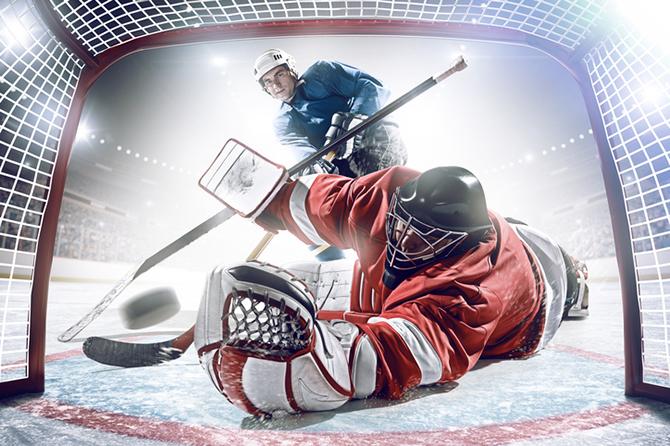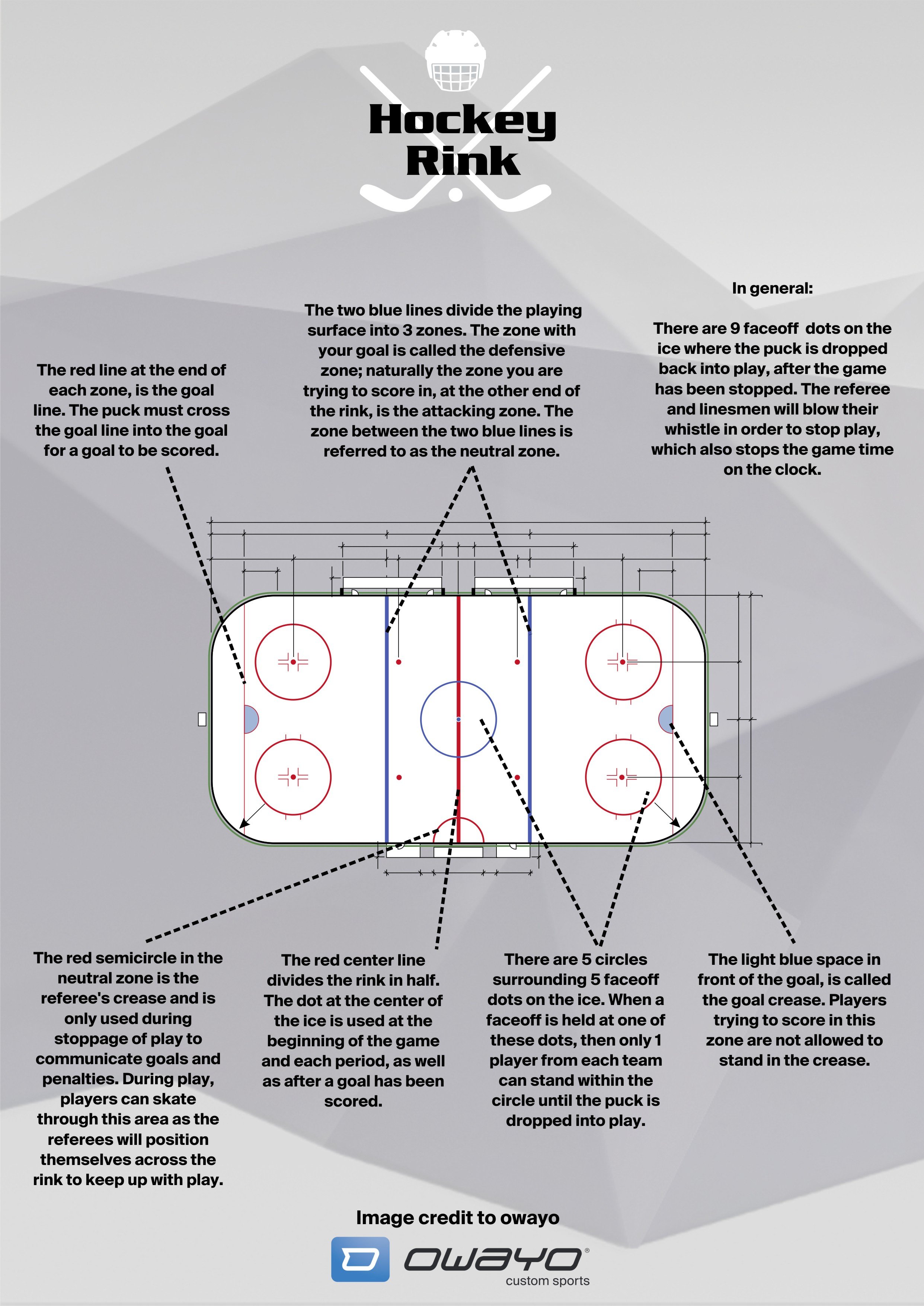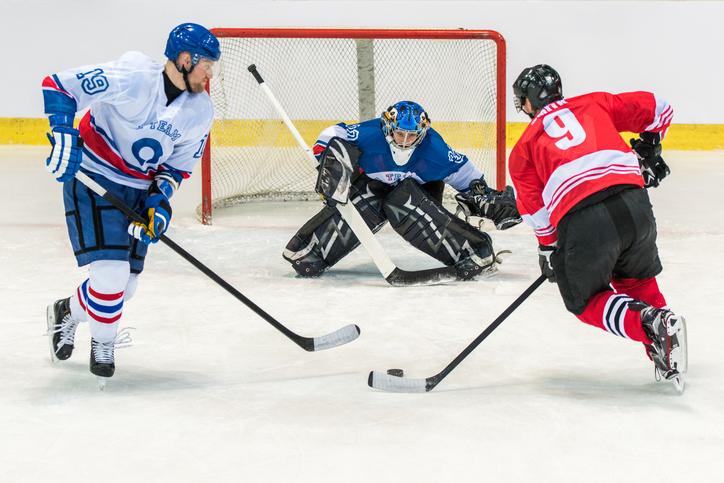Rules of Hockey
The most important rules for dummies

You're going to a game but have no clue about the rules. Then you're in the right place! We will go through to most important rules of the game while keeping it interesting.
In hockey, there are 6 players to each side, one of which is the goalie. The goalie can be pulled for an extra player. Hockey teams usually consist of 4 lines, totally to 20 players.
Hockey is a very intense sport. Players are usually on the ice for only 1 minute at a time before being substituted on the fly. Changing the players is called a "line change"
As the Puck is relatively small compared to a soccer and as hockey is played very fast, it's very easily to loose sight of what's going on. Which is why lights flash after a goal has been made, so that everyone knows a goal was scored.
There is 60 minutes of ice time in a game, which are split into 3 periods. Between the periods, there are 15 minute breaks. The play clock stops when the puck is not on the ice. During stoppages, the players are usually substituted. Games typically take two and a half hours.
Also, at the end of each period, teams switch sides. When the score is tied at the end of regulation, there is overtime. In the NHL, overtime is played in a 3 on 3 scenario, first goal wins. If after the overtime a goal has not been scored, the game moves into a shootout.
The hockey rink
The hockey rink featuring lines and dots. With that, every line has a reason. We'll explain it.

The rink is divided into three sections by two blue lines. The defensive zone is where your goal is, and the opponent's goal is in the offensive zone. The neutral zone is in the middle.
By the goals, there is the red goal line. In hockey, you may play behind the goals but not in the blue half circle, called crease.
The referee crease can be found in the neutral zone. On the rink, there are 8 red dots - 4 with circles. They are called face off zones . After the play is blown dead, the puck will be placed at the nearest faceoff zone.
Penalties
In hockey, there are often fights. For the layman, this is an exciting part of the game. Physical contact is an important part of the game. It is allowed, and also tactically important, to check your opponent. Fisticuffs are usually punished with a 5 minute penalty for both partys.
So that things don't get out of hand, there are hard rules. We've summarised the most important penalties.
The most important rule is offside. When entering the attacking zone, if you or a team member crosses the blue line before the puck, the play is whistled dead and a faceoff will occur in the neutral zone.
Players are allowed to play the puck with their skates, but players cannot kick the puck into the goal.
Another classic rule break applies to the hockey stick. End of the stick may never be held above the shoulders.
Fouls also include tripping, cross-checking and hooking. Most penaltys are 2 minutes but can go up to 10 minutes. During this time, the team plays a man down. This period is called a power play. If the opposing team score a goal during this time, the penalized player re-enters the game.
The penalty dictates the punishment. The offender can be penalized for up to 10 minutes or even be removed from the game and suspended from following games.

The hockey encyclopedia
Here are the most common hockey terms:
Face-off: After a stop in play, the referee throws the puck into play at one of many face-off circles. The two players taking the face-off stand across from each other. Both battle for team possession of the puck.
Icing: Behind each goal is a thin long blue line, and in the middle of the rink is a red line. If a player shoots the puck from behind the red line and it crosses the thin blue line in the offensive zone without touching a stick, icing is called. A face-off then occurs in the defensive zone. If a team is shorthanded, they may ice the puck without icing being called.
Penalty: Penalty Shot: The tripped player is allowed a 1 on 1 with the opposing goalie. The ref calls a penalty shot when a player has a clear chance at a goal but he is fouled in order to ruin his chance. Usually this happens on a break away when a trailing defending trips the forward. A penalty shot is called when the following criteria have been met:
The foul does not take place in the defensive end.
The fouled play has the puck.
The player is attacked from behind.
A clear scoring chance was nullified through the offense.
There are no people between the fouled player and the goalie.
When a penalty shot is called, the following rules apply:
Only the fouled player may shoot.
Only the player and goalie may be on the ice.
The goalie may not leave the crease until the puck at mid ice is played.
There is only one shot.
Overtime: Overtime: If regulation ends with both teams tied, there will be an extra sudden death overtime period of 5 minutes played. In the NHL, overtime is played 3 on 3. First goal wins. If there is no winner, then there is a shootout. Leagues have many different rules.
Playoffs Playoffs: In the playoffs, the top teams will be played in a tournament to decide the best team. In the NHL, 16 teams are in the playoffs. In the round of 16, the best western conference team faces the worst western conference team. Play-offs are played in a best of 7. One team must win 4 times in order to advance.
Hybrid Icing Explained
Fans cheering
To get you pumped up for the game, here's what you can expect. Notice the atmosphere, the intensity and the mood.
Watch this summary to get a quick overview of all the rules of hockey.
There are also rules concerning the uniform. All members of a team must look identical. That doesn't just apply to the jersey, but also the helmet, pants and socks. Of course the goalie has his own helmet. owayo offers a large sortiment of hockey jerseys and accessories, which you can customize yourself. Just take a look.
We hope we were about to give you an introduction into Hockey's most important rules and wish you much fun while you watch in the arena.
Photos: Main photo: ©istock/Dmytro Aksonov, Photo 1:©istock/ simonkr